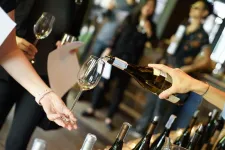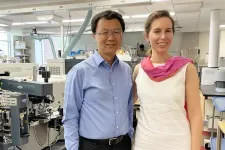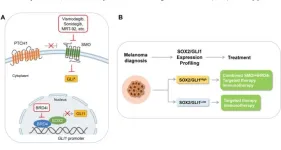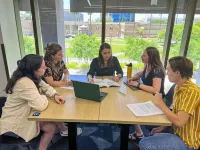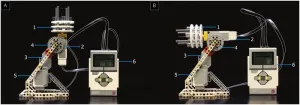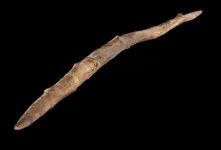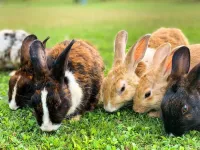(Press-News.org) New research from the University of British Columbia's Okanagan campus has determined that enjoying a tasting at a winery goes well beyond the sip.
Professor Annamma Joy, with UBCO’s Faculty of Management, conducts research in the area of consumer behaviour and branding with a special focus on luxury brands, fashion brand experiences, wineries and wine tourism.
Dr. Joy, along with her collaborators and students, studied several Okanagan wineries over a three-year period to comprehensively document the experiences of visitors. Each year, BC’s wineries welcome more than one million people, and Dr. Joy’s latest research—published this month in the Journal of Retailing—confirms people are judging more than what is in the glass.
For the study, the researchers detailed a number of items including the material features of the winery and the sensorial theme, such as music and lighting. They took note of everything including the landscape, architecture, views from the windows, layout of the store and the physical space of the tastings. Even the social interaction between staff and customers was considered.
Each of these elements are subjectively perceived and work together in the cocreation of “affective atmospheres” that are central to the success of a winery, she explains.
“We confirmed that a winery consumer’s experience is individual and shaped, in part, by their knowledge of wine and understanding of preference,” says Dr. Joy. “Not only is the experience influenced by the aesthetics of the winery, the service received and the wine itself, but also by differences between novices, experts and enthusiasts.”
Dr. Joy explains that the research findings have implications for winery operators when they consider the desired consumer experience. For instance, visitors with a high level of expertise may view sensory stimulation and social interactions with other experts as more important to the visit.
“Wineries that consider the dynamic interaction between customer’s orientation and their level of expertise may create more positive experiences,” says Dr. Joy. “Overall, it is clear that staff being themselves and being sensitive to specific visitor needs and making them feel welcome, is crucial for visitor appreciation of the winery.”
She suggests the findings highlight the importance of a holistic approach to achieving consistency across material features, sensorial modalities and social interactions of a winery.
“By recognizing the interplay of these elements, retailers can strategically design their spaces and interactions to cultivate specific emotional experiences for their customers.”
The findings have implications for retailers outside of the wine industry, she adds.
“Experience-driven and knowledge-based industries where there are discernable differences between novices, experts and enthusiasts may consider how to—through their retail atmospherics—respond according to these needs and expectations.”
So, what does it take for a first-time customer to experience a sense of belonging at a winery?
“The answer is quite simply connection,” she adds. “People desire connection to enhance their experience, and wineries need staff members who are prepared to respond and improvise as needed to strengthen that connection between the customers.”
END
Winery experiences affected by more than what is in your glass
UBC Okanagan researcher explores how a winery visit is shaped
2023-07-19
ELSE PRESS RELEASES FROM THIS DATE:
Researchers use mass spectrometry to explore antimicrobial resistance
2023-07-19
Laura-Isobel McCall, Ph.D., and Zhibo Yang, Ph.D., co-principal investigators and associate professors of chemistry and biochemistry in the Dodge Family College of Arts and Sciences at the University of Oklahoma, have been awarded a prestigious R01 grant from the National Institutes of Health for their project, “Novel single-cell mass spectrometry to assess the role of intracellular drug concentration and metabolism in antimicrobial treatment failure.”
“Our project builds upon Dr. ...
Novel therapeutic strategy against melanoma: combined targeting of hedgehog signaling and BRD4
2023-07-19
“This evidence strengthens the relevance of the findings by Pietrobono et al., shedding light on the potential application of SMO inhibitors in concert with BRD4 inhibitors.”
BUFFALO, NY- July 19, 2023 – A new editorial paper was published in Oncotarget's Volume 14 on May 26, 2023, entitled, “Combined targeting of HEDGEHOG signaling and BRD4 as a novel therapeutic option against melanoma.”
The Hedgehog-GLI (HH/GLI) pathway is aberrantly activated in several types of cancer. Canonical HH/ GLI pathway is triggered by binding of HH ligands to the twelve-pass transmembrane receptor Patched 1 (PTCH1), which retrieves its inhibition ...
Large study finds small associations between systemic inflammation and later dementia
2023-07-19
A study of data from about 500,000 people in the UK Biobank has uncovered small but statistically significant associations between signs of systemic inflammation and later risk of dementia. Dr. Krisztina Mekli of The University of Manchester, UK, and colleagues present these findings in the open-access journal PLOS ONE on July 19, 2023.
Millions of people around the world have Alzheimer’s disease or other types of dementia, and researchers are working to tease out the complex mechanisms behind these conditions. Prior research has suggested that inflammation—activation of the body’s innate immune system—may ...
STEM instructors who are women drive disclosure of concealable stigmatized identities to undergraduates
2023-07-19
Women working as STEM instructors are more likely than men in the same profession to disclose to their undergraduate students identities which could carry stigma, such as depression or growing up in a low-income household. In the new study, published July 19, 2023 in the open-access journal PLOS ONE, Carly Busch of Arizona State University, USA, and colleagues suggest that these decisions to disclose may be in order to act as role models for students.
Concealable stigmatized identities (CSIs) are identities that ...
Researchers used a LEGO robotics kit as a cheap, effective way to purify self-assembling DNA origami
2023-07-19
Article URL: https://journals.plos.org/plosone/article?id=10.1371/journal.pone.0283134
Article Title: Gradient-mixing LEGO robots for purifying DNA origami nanostructures of multiple components by rate-zonal centrifugation
Author Countries: USA
Funding: The research in Hariadi lab was supported by the National Institutes of Health Director’s New Innovator Award (1DP2AI144247), National Science Foundation SemiSynBio II (2027215), and Arizona Biomedical Research Consortium (ADHS17-00007401). The funders had no role in study design, data collection and analysis, decision to publish, or preparation of the manuscript. END ...
A 300,000 year-old double-pointed wooden stick was produced by Middle Pleistocene humans using sophisticated woodworking techniques and was likely used for throwing during hunts
2023-07-19
Article URL: https://journals.plos.org/plosone/article?id=10.1371/journal.pone.0287719
Article Title: A double-pointed wooden throwing stick from Schöningen, Germany: Results and new insights from a multianalytical study
Author Countries: UK, Germany
Funding: T.T. and this project are funded by the Deutsche Forschungsgemeinschaft (DFG, German Research Foundation) – project number 447423357. https://www.dfg.de/. The project is further funded by the Lower Saxony Ministry for Science and Culture, with funds from the Future Lower Saxony Programme of the Volkswagen Foundation – project ...
1 in 5 rabbit owners in the UK report painful or debilitating ear disease in their pet, though it may be under-diagnosed and under-treated, with lop-eared and older rabbits being most at risk
2023-07-19
Article URL: https://journals.plos.org/plosone/article?id=10.1371/journal.pone.0285372
Article Title: Ear health and quality of life in pet rabbits of differing ear conformations: A UK survey of owner-reported signalment risk factors and effects on rabbit welfare and behaviour
Author Countries: UK
Funding: The authors received no specific funding for this work. M.R.D.K included some of this questionnaire in part-fulfilment of her Bachelor of Veterinary Medicine at Royal Veterinary College. ...
CHOP researchers reveal how NSAIDs worsen C. difficile infections
2023-07-19
Philadelphia, July 19, 2023—Why do nonsteroidal anti-inflammatory drugs (NSAIDs) exacerbate gastrointestinal infections by Clostridioides difficile, the leading cause of antibiotic-associated diarrhea worldwide? In a new paperpublished in Science Advances, researchers at Children’s Hospital of Philadelphia (CHOP) have begun to answer that question, showing that NSAIDs disrupt the mitochondria of cells lining the colon, sensitizing them to damage by pathogenic toxins.
Clostridioides ...
Early humans were weapon woodwork experts, study finds
2023-07-19
A 300,000-year-old hunting weapon has shone a new light on early humans as woodworking masters, according to a new study.
State-of-the-art analysis of a double-pointed wooden throwing stick, found in Schöningen in Germany three decades ago, shows it was scraped, seasoned and sanded before being used to kill animals. The research indicates early humans’ woodworking techniques were more developed and sophisticated than previously understood.
The findings, published today (Wednesday, 19 July) in PLOS ONE, also suggest the ...
New therapeutic target for Parkinson’s disease discovered
2023-07-19
· Contacts between lysosomes and mitochondria are broken due to Parkinson’s mutation
· Lysosomes cannot ‘feed’ mitochondria with essential metabolites
CHICAGO --- Northwestern Medicine scientists have uncovered a new mechanism by which mutations in a gene parkin contribute to familial forms of Parkinson's disease. The discovery opens a new avenue for Parkinson’s therapeutics, scientists report in a new study.
The Northwestern scientists discovered that mutations in parkin result in a breakdown ...
LAST 30 PRESS RELEASES:
Superradiant spins show teamwork at the quantum scale
Cleveland Clinic Research links tumor bacteria to immunotherapy resistance in head and neck cancer
First Editorial of 2026: Resisting AI slop
Joint ground- and space-based observations reveal Saturn-mass rogue planet
Inheritable genetic variant offers protection against blood cancer risk and progression
Pigs settled Pacific islands alongside early human voyagers
A Coral reef’s daily pulse reshapes microbes in surrounding waters
EAST Tokamak experiments exceed plasma density limit, offering new approach to fusion ignition
Groundbreaking discovery reveals Africa’s oldest cremation pyre and complex ritual practices
First breathing ‘lung-on-chip’ developed using genetically identical cells
How people moved pigs across the Pacific
Interaction of climate change and human activity and its impact on plant diversity in Qinghai-Tibet plateau
From addressing uncertainty to national strategy: an interpretation of Professor Lim Siong Guan’s views
Clinical trials on AI language model use in digestive healthcare
Scientists improve robotic visual–inertial trajectory localization accuracy using cross-modal interaction and selection techniques
Correlation between cancer cachexia and immune-related adverse events in HCC
Human adipose tissue: a new source for functional organoids
Metro lines double as freight highways during off-peak hours, Beijing study shows
Biomedical functions and applications of nanomaterials in tumor diagnosis and treatment: perspectives from ophthalmic oncology
3D imaging unveils how passivation improves perovskite solar cell performance
Enriching framework Al sites in 8-membered rings of Cu-SSZ-39 zeolite to enhance low-temperature ammonia selective catalytic reduction performance
AI-powered RNA drug development: a new frontier in therapeutics
Decoupling the HOR enhancement on PtRu: Dynamically matching interfacial water to reaction coordinates
Sulfur isn’t poisonous when it synergistically acts with phosphine in olefins hydroformylation
URI researchers uncover molecular mechanisms behind speciation in corals
Chitin based carbon aerogel offers a cleaner way to store thermal energy
Tracing hidden sources of nitrate pollution in rapidly changing rural urban landscapes
Viruses on plastic pollution may quietly accelerate the spread of antibiotic resistance
Three UH Rainbow Babies & Children’s faculty elected to prestigious American Pediatric Society
Tunnel resilience models unveiled to aid post-earthquake recovery
[Press-News.org] Winery experiences affected by more than what is in your glassUBC Okanagan researcher explores how a winery visit is shaped
